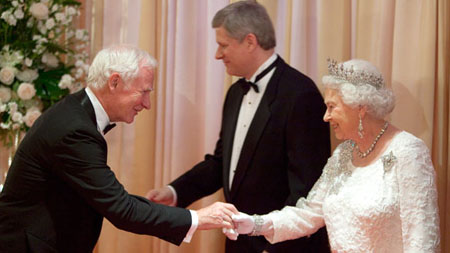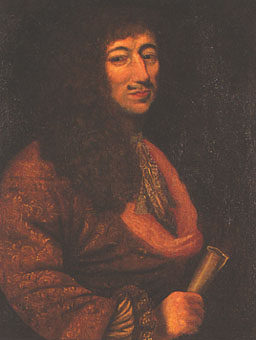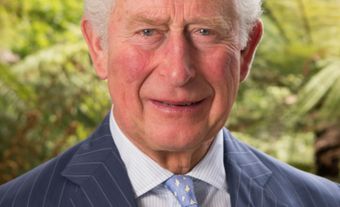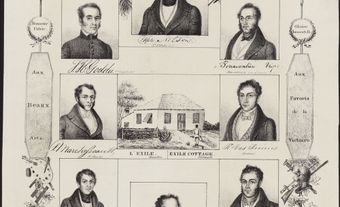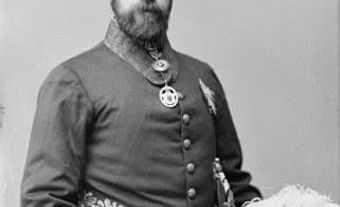Monarchism is support for Canada’s system of government as a constitutional monarchy. Monarchism is distinct from royalism in that it is support for monarchy as a political institution, rather than for an individual monarch. Monarchism played a key role in the development of Canada and continues to be part of political and popular discourse.
Monarchism is support for Canada’s system of government as a constitutional monarchy. Monarchism is distinct from royalism in that it is support for monarchy as a political institution, rather than for an individual monarch. Monarchism played a key role in the development of Canada and continues to be part of political and popular discourse.
French Monarchical Influence
The expeditions of Samuel de Champlain, Jacques Cartier and other French explorers were sponsored by the kings of France, who were absolutist rulers. Monarchism played a key role in these early expeditions: lands were claimed for the king and settlements were often given royal place names. Monarchism also influenced how Europeans engaged with Indigenous peoples as they sought a familiar social hierarchy, identifying a “king” among the leaders of the communities they encountered.
In 1663, King Louis XIV placed New France under his personal control. The king and his finance minister Jean-Baptiste Colbert became directly involved in the governance and expansion of New France. The king appointed a governor, intendant and bishop, and sponsored the emigration of women known as the Filles du Roi (The King’s Daughters).
Influence of the British Monarchy
Early British exploration of Canada was also sponsored by the Crown. The earliest Thanksgiving on what became Canadian soil was celebrated by Martin Frobisher and his crew. They gave thanks for their safe arrival on Baffin Island during a voyage to explore the Northwest Passage, which was sponsored by Queen Elizabeth I (see The First Thanksgiving in North America). In 1670, King Charles II granted the Hudson's Bay Company all the lands in the Hudson Bay drainage basin and appointed his cousin Prince Rupert of the Rhine as the first governor of the company (see also Rupert’s Land).
After French Canada was ceded to the British in the Treaty of Paris in 1763, Britain’s King George III assumed King Louis XV’s role as monarch of the newly expanded British North America. The British constitutional monarchy, however, was very different from the French absolutist monarchy.
Over the centuries, the English monarchy evolved into a constitutional monarchy accountable to Parliament. When King John accepted the Magna Carta in 1215, he became the first English monarch to accept limits on his power that were imposed by his subjects. The earliest meetings of Parliament were called during the reign of his son, King Henry III. In 1689, King William III and Queen Mary II accepted the Bill of Rights. From then on, modern monarchism in Canada consisted of support and advocacy for a constitutional monarchy rather than other forms of monarchical government. The development of responsible government in the 19th century expanded the political class from the wealthy and influential elite to a broader electorate. In so doing, responsible government reinforced a political system in which the monarch acts on the advice of ministers who can command the confidence of Parliament, and more specifically the House of Commons, whose members are popularly elected.
The Crown and Indigenous Peoples
In 1763, King George III issued the Royal Proclamation, which guaranteed Indigenous land rights and remains the foundation of the relationship between the Crown and Canada’s Indigenous peoples. In 1764, representatives of 24 nations concluded the Treaty of Niagara, which ratified the Royal Proclamation and created a new alliance that shaped First Nations’ participation in the War of 1812. The terms of the Royal Proclamation are guaranteed by Canada’s Constitution Act, 1982.
The development of responsible government complicated the relationship between the Crown and Canada’s Indigenous peoples. Monarchism among Indigenous communities was often expressed in personal and familial terms. For example, when Queen Victoria’s son-in-law John Campbell, Marquess of Lorne, toured western Canada in 1881, he was addressed as “brother” and “great brother-in-law” by First Nations leaders.
First Nations monarchism continues to be expressed in terms of a personal relationship with the monarch. In 1982, however, the British Court of Appeal ruled that “the Crown was no longer single and indivisible. It was separate and divisible for each self-governing Dominion or province or territory.” From that point on, the Royal Proclamation was therefore an agreement with the Canadian Crown rather than the British Crown, as it was in 1763.
The Royal Proclamation, the provisions of which are guaranteed in the Charter of Rights and Freedoms, continues to provide a framework for relations between the Canadian government and Canada’s Indigenous peoples. The Idle No More movement called upon the Canadian government to uphold treaty rights according to the Royal Proclamation. The recommendations in the report by the Truth and Reconciliation Commission of Canada (2015) included a call for a new royal proclamation of reconciliation. The report stated, “The proclamation would build on the Royal Proclamation of 1763 and the Treaty of Niagara of 1764, and reaffirm the nation-to-nation relationship between Indigenous peoples and the Crown.”
United Empire Loyalists
The outbreak of the American Revolution divided the population of the Thirteen Colonies between “Patriots” who favoured the establishment of an American republic and “ Loyalists” who wanted to maintain political ties to Britain and the Crown. Around 50,000 Loyalists from diverse backgrounds emigrated to British North America, including First Nations allies of the British during the American Revolution and Black Loyalists. Thousands more “late” Loyalists moved to British North America in the decades following the American Revolution to claim free land grants. For these settlers, monarchism was a central tenet of their cultural identity. Loyalism informed the development of Canada, as numerous Fathers of Confederation, particularly in the Maritime provinces, were the grandchildren of Loyalists and were informed by family traditions of monarchism.
Monarchism and Confederation
Monarchism played a key role in Canada’s Confederation. Queen Victoria favoured self-government for British North America, an arrangement that would reduce Britain’s overseas defence obligations. When John A. Macdonald, George-Étienne Cartier and other Fathers of Confederation visited Britain for the London Conference in 1866, they met with Queen Victoria and received her personal support for Confederation. Fathers of Confederation with a variety of different political and economic stances had a shared loyalty to the Crown, and the Queen’s support helped Macdonald and his political allies overcome regional opposition to the project. Macdonald intended for the new nation to be the Kingdom of Canada, and invited Queen Victoria to open the first session of Parliament on 1 July 1867. The Queen did not open Parliament, though all four of her sons and one of her daughters visited Canada between 1860 and 1883. Samuel Leonard Tilley, another Father of Confederation, is believed to have suggested the designation Dominion of Canada following concerns about how Americans would respond to a kingdom on their northern border. The constitutional monarchy differentiated Canada from the United States and served as an essential part of the new nation’s political and cultural identity.
Monarchism and Canadian Culture
Monarchism was a major part of Canada’s cultural identity in the 19th and early 20th centuries. Loyalty to the Crown made Canadian culture distinct from that of the United States and acted as a unifying force for Canadians of diverse backgrounds. In 1845, the Province of Canada legislated 24 May as a public holiday in honour of Queen Victoria’s birthday — a secular celebration that was embraced in both French and English Canada. Early celebrations of Canadian Thanksgiving were in response to events within the royal family, such as in 1872 when Queen Victoria’s eldest son, the future Edward VII, recovered from typhoid. Royal events such as births, marriages, tours and jubilees were greeted with public celebrations in Canada. (See also Queen Victoria’s Diamond Jubilee — 1897.)
Monarchism is a theme in numerous works of Canadian literature. In Lucy Maud Montgomery’s novel, Anne of Green Gables, Anne discovers an island on Victoria Day and names it after the queen, declaring “Both Diana and I are very loyal.” A major character in Robertson Davies ’ novel Fifth Business models himself after the future Edward VIII and presents the image of having royal connections to get ahead in Canadian society. Lawrence Hill’s novel The Book of Negroes depicts the experiences of Black Loyalists and the central character is received in London by King George III and Queen Charlotte.
Changing French-Canadian Attitudes Toward Monarchy
Prior to the Quiet Revolution of the 1960s, political leaders in Québec viewed the Crown as a protector of the minority rights of French Canadians within the larger context of English Canada, a relationship that dated back to the Quebec Act, 1774. When King George VI and Queen Elizabeth visited Canada in 1939, they were greeted by cheering crowds in Montréal and Québec City, and celebrations in honour of Queen Elizabeth II’s coronation were held on the Plains of Abraham in 1953 (see Battle of the Plains of Abraham).
Attitudes toward the monarchy in Québec changed with the rise of the Quiet Revolution during the 1960s, when the Crown was interpreted as a symbol of British oppression. The Queen encountered protestors when she visited Québec City in 1964. There’s evidence that attitudes toward the monarchy have gradually become more positive in recent years, but monarchism remains far less widespread in Québec than in other regions of Canada.
Modern Constitutional Monarchy
Canada’s Constitution Act, 1982 states in Section 41a that changes to “the office of the queen” must be approved by the Senate, the House of Commons and all 10 provincial legislatures. Changing Canada’s political system would be complex. There are not only monarchists who support the current political system, but also people who are indifferent to the monarchy who also oppose reopening the constitution for a variety of reasons. The public image of monarchism in modern Canada is closely associated with the promotion of visible symbols of the constitutional monarchy, including royal tours, portraiture and heraldry.
Polls regarding the number of monarchists who actively support Canada’s current constitutional monarchy, as opposed to people who are indifferent or favour a change in political system, vary widely depending on the question and the timing of the poll. A popular royal tour in Canada often increases support for the monarchy, while questions that emphasize cost or other financial aspects of monarchy result in lower percentages of professed monarchists.
Monarchist Societies in Canada
There are numerous Canadian societies that advocate the merits of constitutional monarchy as Canada’s system of government and/or educate Canadians about the history of the constitutional monarchy. These societies include:
The United Empire Loyalists' Association of Canada, founded in 1914, fosters public awareness of the contributions the United Empire Loyalists made to Canada.
The Royal Commonwealth Society of Canada is the Canadian branch of the Royal Commonwealth Society founded in 1868. This society advocates for the Commonwealth as a force for good in the world, as well as youth leadership and dialogue opportunities throughout the Commonwealth.
The Monarchist League of Canada, founded in 1970, promotes the benefits of the constitutional monarchy as Canada’s political system and lobbies all levels of government to make the Crown and royal symbols visible to Canadians.
The Canadian Royal Heritage Trust, a national educational charity established in 1994, informs Canadians about the role of the constitutional monarchy in Canada’s history and increases knowledge of the role of the Crown in Canada’s political system.
There are also academics based at a variety of Canadian universities and think tanks who advocate the importance of Canada’s constitutional monarchy to Canadian history, politics and law through their research.
Critiques of Monarchism
In the 19th century, British monarchism was critiqued by Canadian journalists who wanted to see the emergence of a distinct Canadian Crown that combined the traditions of loyalism with an accessible public image more suitable to an egalitarian and North American context. Royalty who visited Canada, and especially royalty who resided there for long periods, were expected to embrace Canadian cultural traditions.
In the late 20th century, Canada’s constitutional monarchy was critiqued with a broad range of arguments. These included how relevant a monarch who resided in the United Kingdom was to an increasingly multicultural Canada, the declining popularity of the monarchy in modern Québec, the cost of royal tours, and personal reputations of various members of the royal family.
There are Canadian societies that advocate the abolition of the monarchy, including Citizens for a Canadian Republic; and Your Canada, Your Constitution, but their membership and influence is low compared to similar movements in Australia, where the future of the monarchy was the subject of a 1999 referendum.
In recent years, there have been cases of new Canadians from a variety of nations, including, Ireland, Jamaica and Israel, objecting to swearing allegiance to the queen as part of Canada’s citizenship oath.
Monarchism in the Commonwealth
In addition to her role as queen of Canada, Elizabeth II is queen of the United Kingdom and 13 other Commonwealth countries. Individual monarchists and monarchist societies in other Commonwealth nations support the constitutional monarchy with arguments derived from each nation’s individual relationship with the Crown. In Australia, monarchists defended the Crown’s role in the political system during a referendum on the future of the monarchy. In New Zealand, monarchists highlighted how important the Crown was to the modern nation, which dates from the Treaty of Waitangi between the Crown and the Maori people. In the Caribbean countries, monarchism is often expressed in terms of personal loyalty to the monarch. Even heads of government who favour and seek republicanism, such as the prime ministers of Jamaica and Barbados, emphasize their personal respect for the queen in their public statements.
In September 2020, Barbados announced its intention to become a republic and remove Queen Elizabeth II as its head of state. "The time has come to fully leave our colonial past behind," the government stated. The Barbadian government became a republic in November 2021, which was the 55th anniversary of the nation’s independence from Britain. The development prompted renewed discussion of the monarchy’s future in Canada.

 Share on Facebook
Share on Facebook Share on X
Share on X Share by Email
Share by Email Share on Google Classroom
Share on Google Classroom

